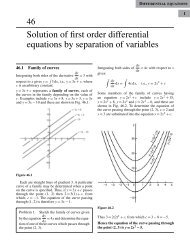trigonometry
Create successful ePaper yourself
Turn your PDF publications into a flip-book with our unique Google optimized e-Paper software.
Geometry and <strong>trigonometry</strong><br />
Assignment 4<br />
This assignment covers the material contained<br />
in Chapters 12 to 14.<br />
P<br />
The marks for each question are shown in<br />
brackets at the end of each question.<br />
O<br />
Q<br />
R<br />
1. A 2.0 m long ladder is placed against a perpendicular<br />
pylon with its foot 52 cm from the pylon.<br />
(a) Find how far up the pylon (correct to the nearest<br />
mm) the ladder reaches. (b) If the foot of the<br />
ladder is moved 10 cm towards the pylon how<br />
far does the top of the ladder rise?<br />
(7)<br />
2. Evaluate correct to 4 significant figures:<br />
(a) cos 124 ◦ 13 ′ (b) cot 72.68 ◦ (4)<br />
3. From a point on horizontal ground a surveyor<br />
measures the angle of elevation of a church spire<br />
as 15 ◦ . He moves 30 m nearer to the church and<br />
measures the angle of elevation as 20 ◦ . Calculate<br />
the height of the spire. (9)<br />
4. If secant θ = 2.4613 determine the acute<br />
angle θ (4)<br />
5. Evaluate, correct to 3 significant figures:<br />
3.5 cosec 31 ◦ 17 ′ − cot (−12 ◦ )<br />
3 sec 79 ◦ 41 ′ (5)<br />
6. A man leaves a point walking at 6.5 km/h in<br />
a direction E 20 ◦ N (i.e. a bearing of 70 ◦ ). A<br />
cyclist leaves the same point at the same time<br />
in a direction E 40 ◦ S (i.e. a bearing of 130 ◦ )<br />
travelling at a constant speed. Find the average<br />
speed of the cyclist if the walker and cyclist are<br />
80 km apart after 5 hours. (8)<br />
7. A crank mechanism shown in Fig. A4.1 comprises<br />
arm OP, of length 0.90 m, which rotates<br />
anti-clockwise about the fixed point O, and connecting<br />
rod PQ of length 4.20 m. End Q moves<br />
horizontally in a straight line OR.<br />
Figure A4.1<br />
(a) If ∠POR is initially zero, how far does end<br />
Q travel in 1 4 revolution<br />
(b) If ∠POR is initially 40 ◦ find the angle<br />
between the connecting rod and the horizontal<br />
and the length OQ<br />
(c) Find the distance Q moves (correct to the<br />
nearest cm) when ∠POR changes from 40 ◦<br />
to 140 ◦ (16)<br />
8. Change the following Cartesian co-ordinates<br />
into polar co-ordinates, correct to 2 decimal<br />
places, in both degrees and in radians:<br />
(a) (−2.3, 5.4) (b) (7.6, −9.2) (10)<br />
9. Change the following polar co-ordinates into<br />
Cartesian co-ordinates, correct to 3 decimal<br />
places: (a) (6.5, 132 ◦ ) (b) (3, 3 rad) (6)<br />
10. (a) Convert 2.154 radians into degrees and<br />
minutes.<br />
(b) Change 71 ◦ 17 ′ into radians (4)<br />
11. 140 mm of a belt drive is in contact with a pulley<br />
of diameter 180 mm which is turning at 300<br />
revolutions per minute. Determine (a) the angle<br />
of lap, (b) the angular velocity of the pulley, and<br />
(c) the linear velocity of the belt assuming that<br />
no slipping occurs. (9)<br />
12. Figure A4.2 shows a cross-section through a<br />
circular water container where the shaded area<br />
represents the water in the container. Determine:<br />
(a) the depth, h, (b) the area of the shaded










